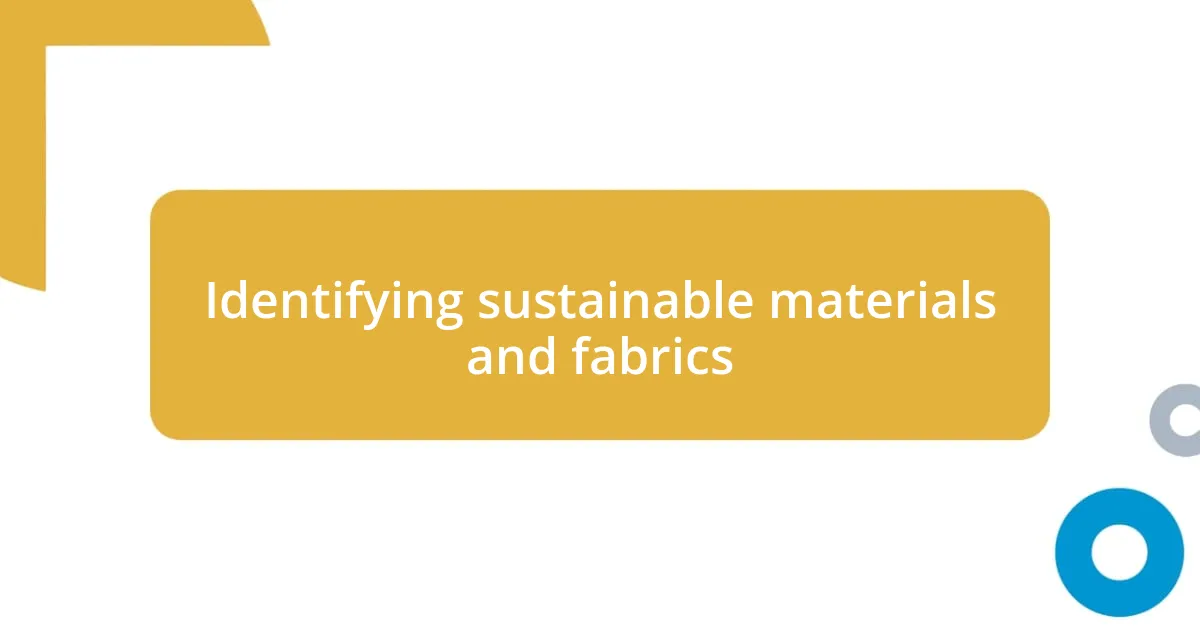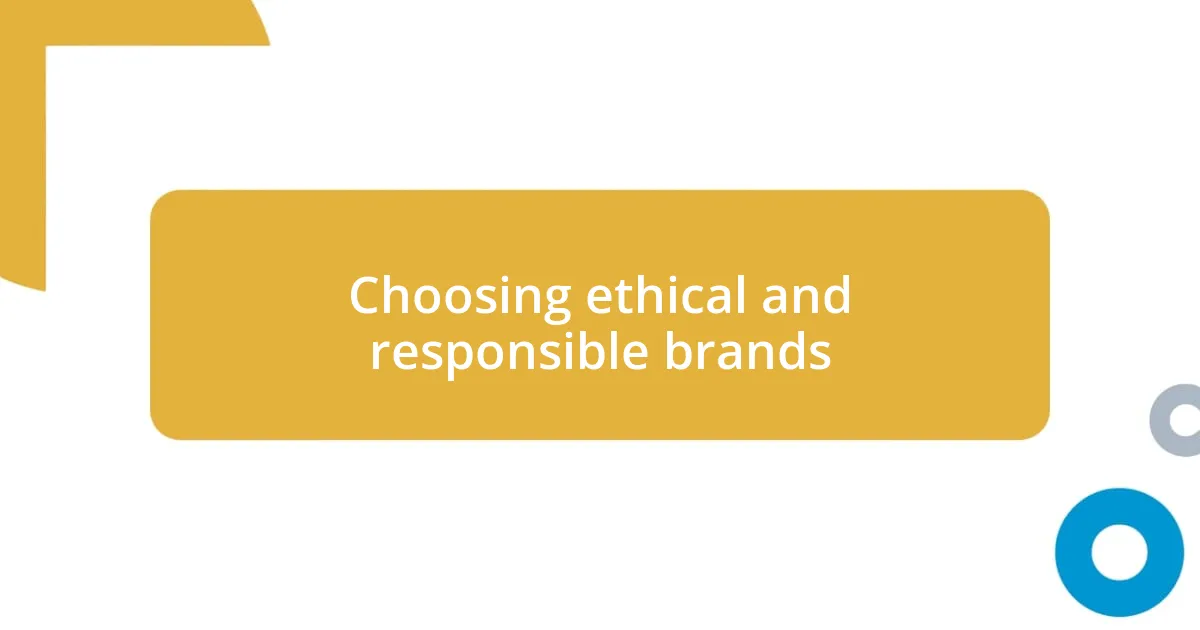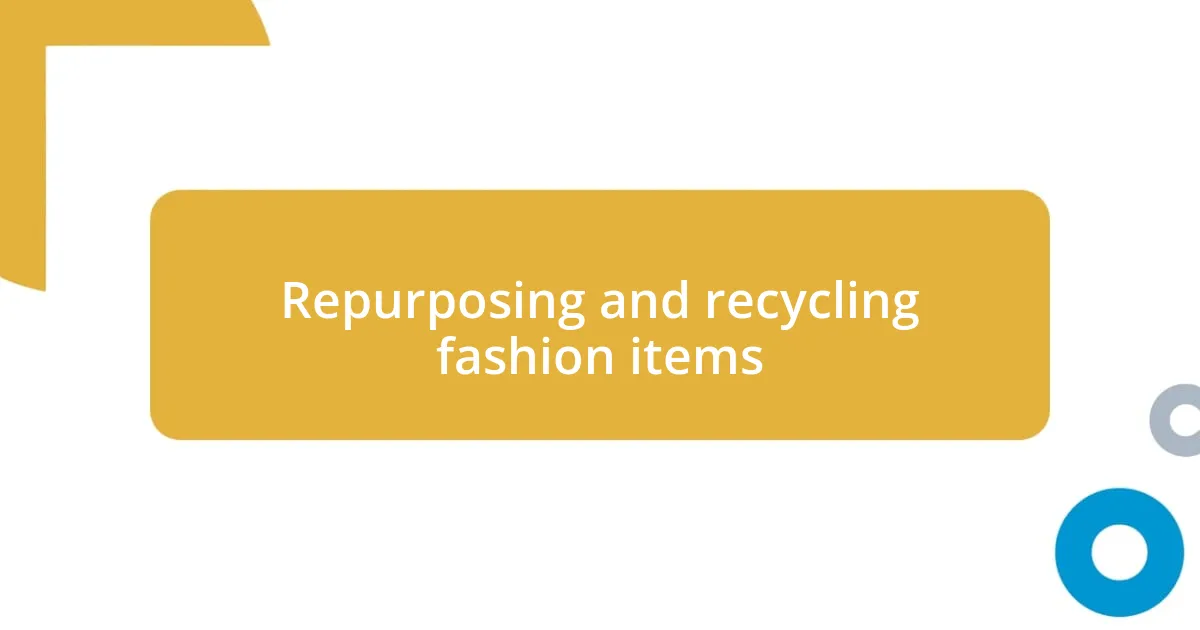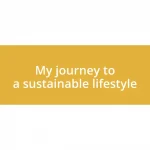Key takeaways:
- Sustainable fashion emphasizes eco-friendly materials, ethical labor practices, and waste reduction.
- Utilizing sustainable fabrics like Tencel and recycled polyester, along with certifications like GOTS, enhances conscious wardrobe choices.
- Building a versatile wardrobe involves selecting classic styles, layering, neutral colors, and focusing on quality and fit.
- Repurposing and recycling fashion items fosters creativity and community connection, contributing to sustainable practices.

Understanding sustainable fashion principles
Sustainable fashion principles revolve around eco-friendly materials, ethical labor practices, and the reduction of waste. I remember the first time I switched to organic cotton; it felt like a small act, yet I realized that every garment I chose could align with my values. Isn’t it invigorating to think that our fashion choices can contribute to a healthier planet?
When considering sustainable fashion, it’s vital to examine not just what we wear but also where and how it’s made. I often find myself pondering the stories behind the pieces in my wardrobe. Each item carries its own tale—harvested responsibly, crafted by artisans earning a fair wage, or shipped in reduced packaging. How can we not care about the impact of our choices?
Moreover, embracing a circular approach is essential. I’ve noticed how my perspective shifted when I started thrifting and repairing clothes instead of buying new. It’s not just better for the environment; it also adds character to my wardrobe. Have you experienced the joy of giving new life to a piece that might otherwise end up in landfills? Every act counts, and this mindset fosters a deeper connection to fashion that transcends fleeting trends.

Identifying sustainable materials and fabrics
Identifying sustainable materials and fabrics can be a transformative journey for anyone who cares about the environment. When I stumbled upon Tencel, a fiber made from sustainably harvested wood pulp, I was amazed. It feels incredibly soft, and knowing that it’s biodegradable took my love for it to the next level. Have you tried it? It blends comfort with eco-consciousness effortlessly, making it a fabulous choice for anyone looking to make more responsible wardrobe decisions.
Another material that has piqued my interest is recycled polyester. At first, I was skeptical about the thought of wearing something that started as plastic bottles. However, after discovering how much waste this option helps reduce, I embraced it wholeheartedly. The garments not only look great but also serve as a conversation starter about sustainability. I often find myself sharing the story of my sustainable wardrobe with friends. What if more of us wore recycled materials? It could fundamentally change how we view fashion.
Lastly, certifications like GOTS (Global Organic Textile Standard) can be invaluable when it comes to identifying sustainable fabrics. These labels provide assurance that the materials meet strict environmental and social criteria. I remember the thrill of finding a dress that bore the GOTS label—it felt like a badge of honor. Knowing that my fashion choices align with sustainable practices makes each purchase feel meaningful.
| Material | Key Characteristics |
|---|---|
| Tencel | Soft, biodegradable, from sustainably harvested wood pulp |
| Recycled Polyester | Made from plastic waste, reduces landfill impact, durable |
| GOTS-Certified Fabrics | Meets strict environmental and social standards, provides assurance |

Building a versatile wardrobe sustainably
Building a versatile wardrobe sustainably is about making mindful choices that prioritize quality and adaptability. I remember curating my own capsule wardrobe; it was an eye-opener. I realized that fewer, high-quality pieces could create countless outfits. The beauty lies in selecting items that genuinely resonate with my personal style while being versatile enough to transition from day to night or season to season.
Here are some strategies I’ve found effective in this pursuit:
- Choose classic styles: Timeless pieces like a well-fitted blazer or a little black dress can serve as foundations that never go out of style.
- Opt for layering: Invest in lightweight tops and cardigans that can be mixed and matched to create new looks without needing lots of garments.
- Utilize versatile accessories: Scarves, belts, and statement jewelry can transform a simple outfit and make it feel fresh.
- Prioritize neutral colors: A palette of neutrals allows for endless combinations and ensures that everything works together effortlessly.
- Focus on fit and fabric: Selecting pieces that feel good on the body and are made from sustainable materials can elevate the entire wardrobe experience.
Adopting these principles has allowed me to embrace sustainability without sacrificing style. I often find myself creating outfit possibilities in my head—it’s almost like a fun puzzle. The excitement of knowing that each piece has a role and a purpose sparks a deep satisfaction within me. Isn’t it remarkable how a thoughtful wardrobe can reflect both our values and individuality?

Choosing ethical and responsible brands
Choosing ethical and responsible brands is like embarking on a treasure hunt. When I discovered a local boutique that prioritizes fair trade, I felt an instant connection to the artisans behind those products. Each piece told a story, and I loved thinking about the individuals who had crafted it with care. It’s a beautiful feeling to support brands that value ethical labor practices, and it makes my purchasing choices feel significant.
I’ve learned that transparency in sourcing is crucial. When I researched my favorite brands, I felt proud to support those that openly share their manufacturing processes and labor conditions. It’s true, some brands go the extra mile by providing detailed information on where their materials come from and how their workers are treated. Have you ever noticed how empowering it is to wear something that aligns with your values? That sense of integrity fuels my passion for sustainable fashion even more.
Lastly, I always look for brands that have a positive environmental impact. I remember spotting a brand that not only uses sustainable materials but also commits to reducing waste through initiatives like recycling programs. Knowing that they actively contribute to environmental restoration made me an instant fan. By choosing to support these brands, I feel like I’m part of a movement pushing for a brighter future in fashion. Does it make you reconsider your wardrobe choices too? I think it could be a pivotal change for many of us!

Repurposing and recycling fashion items
Repurposing and recycling fashion items has opened a world of creativity for me. I vividly remember transforming an old pair of jeans into a stylish denim tote. It felt rewarding to breathe new life into something I no longer wore, and it sparked joy to carry a bag that tells a story of renewal. Have you ever considered what could be created from the items gathering dust in your closet? It’s like an adventure waiting to unfold!
I’ve also found that local swap events are a fantastic way to repurpose. I attended one recently where I exchanged a few dresses I no longer wore for some unique pieces that perfectly matched my evolving style. The thrill of finding something “new” while letting go of what I didn’t love anymore felt liberating! It’s a wonderful reminder that sustainable fashion doesn’t have to come from stores; sometimes, all it takes is a little community connection.
Moreover, I often dive into DIY projects for my fashion items. One weekend, I embellished a plain white T-shirt with fabric paint and unique patches. It became a conversation starter and a reflection of my personality. I can’t help but wonder: could a simple afternoon of crafting ignite your passion for sustainability too? By repurposing and recycling, we can create distinctive pieces that not only look great but also represent our commitment to a more sustainable future.












